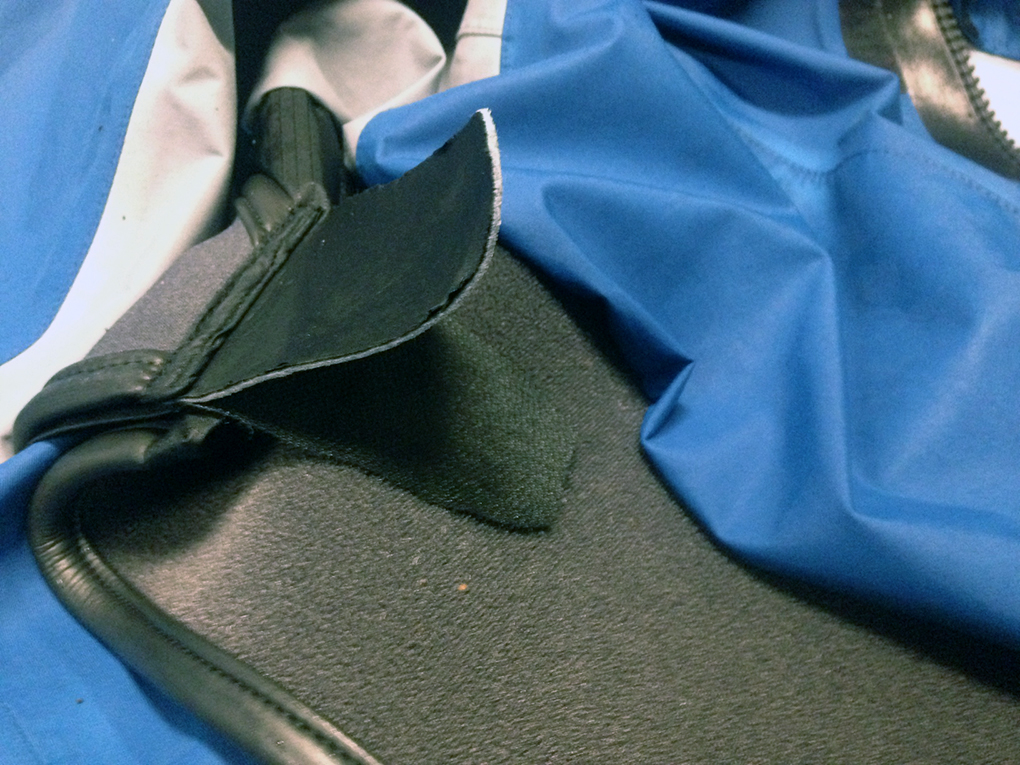Comfort and Sizing
The fabric that NRS has used for the Crux (proprietary 4-layer waterproof/breathable) feels thicker and stiffer compared to the GORE-TEX Kokatat suits and IR Supermodel.
On the one hand, the Eclipse fabric has proven to be durable, thanks in part to its thickness. I have done some pretty significant bushwhacking through thorny thickets of blackberries and Devil’s Club and haven’t had any tears or punctures in the material. And at the same time, this hasn’t affected my range of motion thanks to the generous amount of material that NRS uses for the cut of the suit. I’m 5’10”, and the Large suit has plenty of room to spare. I could probably size down to the Medium, but the extra room in the Large is nice because it makes the suit easy to put on and take off. The roomier fit is also nice when playboating, since it permits a lot of movement through a wide range of motion. I don’t feel restricted at all in the large Crux while playboating. (The bagginess ends up looking pretty “steezy,” too.)

As a side note, the Crux in blue really pops and the color looks great for photos, so the color and style of this suit are a bonus.
Durability
As mentioned above, the waterproof/breathable Eclipse fabric has performed well so far, and I am not seeing any signs of leakage through high wear points at the knees, elbows, and on the butt. In fact, the fabric is still beading water off of low-wear points like my forearms. I’ve worn the suit on portages that require a lot of scraping against sharp rocks on Robe Canyon, so it is a good sign that the material is holding up to this sort of use.
Sixteen days isn’t truly enough testing time to comment on the overall durability of other components of the suit’s construction (materials besides the fabric itself), but I am seeing some early signs of wear and tear.
I have already had a minor failure on the hook-and-loop closure around the outer fabric of the tunnel. The velcro closure has separated from the backing material. While this is a minor issue that I will fix easily with some Aquaseal, it is slightly disconcerting to see this after just 16 days wearing the suit.

Again, overall the Crux continues to succeed in the most important way: it’s ability to keep me dry. I will update this review when I have more days in the suit and can comment further on long-term durability.
Bottom Line
If you plan to put 100 days a year in a drysuit, it may be worth it to spend the money on a top of the line Kokatat. And if you only plan to use your drysuit occasionally, check out cheaper brands/models like the Stohquist AMP. The Crux sits in the middle between these two price points, striking a great balance of cost and quality for paddlers who need a very dry, capable suit, but who can’t quite stomach $1150 or more for Kokatat or Sweet dry suits.
NRS has upped their game from the Inversion by creating a new suit that is more comfortable and trustworthy. All this, combined with NRS’s excellent customer service, should give paddlers confidence in dropping a still significant amount of cash on the Crux.

Hi David, could you comment on the breathability differences between the NRS crux and Kokatat GMER. You mentioned the durability and thickness between the two, but never directly compared the breathability. That would really be my deciding factor on upgrading to a GMER. Thanks, and great review!